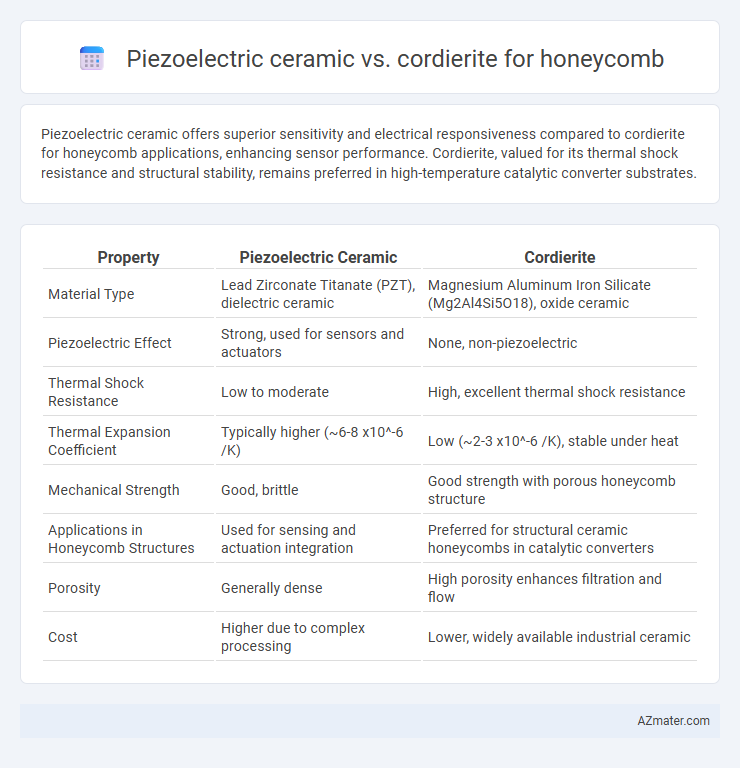Piezoelectric ceramic offers superior sensitivity and electrical responsiveness compared to cordierite for honeycomb applications, enhancing sensor performance. Cordierite, valued for its thermal shock resistance and structural stability, remains preferred in high-temperature catalytic converter substrates.
Table of Comparison
| Property | Piezoelectric Ceramic | Cordierite |
|---|---|---|
| Material Type | Lead Zirconate Titanate (PZT), dielectric ceramic | Magnesium Aluminum Iron Silicate (Mg2Al4Si5O18), oxide ceramic |
| Piezoelectric Effect | Strong, used for sensors and actuators | None, non-piezoelectric |
| Thermal Shock Resistance | Low to moderate | High, excellent thermal shock resistance |
| Thermal Expansion Coefficient | Typically higher (~6-8 x10^-6 /K) | Low (~2-3 x10^-6 /K), stable under heat |
| Mechanical Strength | Good, brittle | Good strength with porous honeycomb structure |
| Applications in Honeycomb Structures | Used for sensing and actuation integration | Preferred for structural ceramic honeycombs in catalytic converters |
| Porosity | Generally dense | High porosity enhances filtration and flow |
| Cost | Higher due to complex processing | Lower, widely available industrial ceramic |
Introduction to Honeycomb Materials
Piezoelectric ceramic and cordierite are two prominent materials used in honeycomb structures, each offering distinct benefits based on their properties. Piezoelectric ceramics provide excellent electrical responsiveness and mechanical stability, making them ideal for sensors and actuators within honeycomb designs. Cordierite, known for its low thermal expansion and high thermal shock resistance, is favored in catalytic converter substrates and other high-temperature applications where durability and thermal management are critical.
Overview of Piezoelectric Ceramics
Piezoelectric ceramics are advanced materials that generate electric charge under mechanical stress, making them essential for sensors and actuators in honeycomb structures. Their high piezoelectric coefficient and stability under varying temperatures provide precise control and responsiveness compared to non-piezoelectric ceramics like cordierite. Unlike cordierite, which excels mainly in thermal shock resistance and structural support, piezoelectric ceramics enable active functionality in honeycomb applications.
Properties of Cordierite Honeycomb
Cordierite honeycomb exhibits excellent thermal shock resistance and low thermal expansion, making it ideal for applications involving rapid temperature changes such as catalytic converters and filters. Its high chemical stability and durability ensure long service life in harsh environments, outperforming piezoelectric ceramic in heat resistance and mechanical strength. The porous honeycomb structure of cordierite enhances gas flow efficiency and reduces backpressure, critical for emission control and filtration systems.
Comparative Mechanical Strength
Piezoelectric ceramic honeycombs exhibit superior mechanical strength with higher fracture toughness and compressive strength compared to cordierite, making them more resistant to cracking under stress. Cordierite honeycombs offer good thermal shock resistance but tend to have lower flexural strength and are more brittle under mechanical loads. The enhanced durability of piezoelectric ceramics supports applications requiring robust structural integrity in high-vibration or pressure environments.
Thermal Stability and Resistance
Piezoelectric ceramics offer superior thermal stability withstanding high temperatures up to 800degC, maintaining consistent piezoelectric properties essential for sensors and actuators in demanding environments. Cordierite honeycomb structures exhibit excellent thermal shock resistance and low thermal expansion, making them ideal for catalytic converter substrates where rapid temperature fluctuations occur. Both materials provide distinct advantages: piezoelectric ceramics excel in stable electrical performance under heat, while cordierite ensures mechanical durability and resistance to thermal stress in automotive applications.
Electrical Conductivity Differences
Piezoelectric ceramic honeycombs exhibit significantly higher electrical conductivity compared to cordierite due to their intrinsic polarization properties and the presence of conductive metal oxides like lead zirconate titanate (PZT). Conversely, cordierite ceramic honeycombs possess very low electrical conductivity, making them excellent insulators suitable for high-temperature applications without electrical interference. This conductivity contrast directly impacts their application in sensors, actuators, and catalytic converters, where electrical performance and thermal stability are critical.
Manufacturing and Processing Techniques
Piezoelectric ceramic honeycombs are manufactured using advanced tape-casting and precision sintering techniques that enable fine control over pore structure and electrical properties, essential for sensor and actuator applications. Cordierite honeycombs are fabricated through extrusion and firing processes optimized for thermal stability and mechanical strength, commonly used in catalytic converters due to their excellent thermal shock resistance. Processing piezoelectric ceramics demands stringent control of dopants and microstructure to achieve desired piezoelectric coefficients, whereas cordierite's processing focuses on uniformity and pore size distribution for optimal filtration and heat exchange performance.
Applications in Industrial Filtration
Piezoelectric ceramic honeycombs provide precise vibration control and high sensitivity in industrial filtration systems, enhancing particulate matter removal efficiency in automotive and chemical processing applications. Cordierite honeycombs excel in high-temperature resilience and thermal shock resistance, making them ideal for exhaust filters in heavy-duty diesel engines and industrial furnaces. Both materials optimize filtration performance, with piezoelectric ceramics offering advanced vibration-based filtration and cordierite ensuring durability under harsh thermal conditions.
Cost Efficiency and Availability
Piezoelectric ceramic honeycombs generally exhibit higher cost efficiency due to their superior energy conversion properties and durability, making them a preferred choice in applications requiring precise sensing and actuation. Cordierite honeycombs offer broader availability and lower raw material costs, making them economically advantageous for large-scale, high-temperature filtration systems despite less sensitivity compared to piezoelectric ceramics. The choice between the two depends on balancing initial investment with long-term performance needs, where piezoelectric ceramics optimize operational cost savings, and cordierite emphasizes budget-friendly material accessibility.
Conclusion: Choosing the Right Material
Piezoelectric ceramic honeycombs excel in sensitivity and energy conversion, making them ideal for advanced sensor and actuator applications requiring precise responsiveness. Cordierite honeycombs provide superior thermal shock resistance and stability, which is essential in high-temperature environments like automotive catalytic converters. Selecting the right material depends on application-specific demands such as temperature tolerance, mechanical durability, and functional requirements for sensing or structural performance.

Infographic: Piezoelectric ceramic vs Cordierite for Honeycomb
 azmater.com
azmater.com